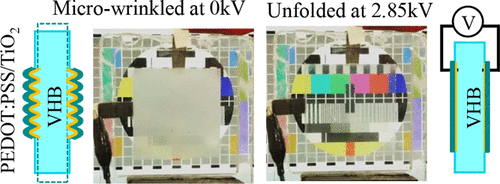当前位置:
X-MOL 学术
›
ACS Photonics
›
论文详情
Our official English website, www.x-mol.net, welcomes your
feedback! (Note: you will need to create a separate account there.)
Smart Window Based on Electric Unfolding of Microwrinkled TiO2 Nanometric Films
ACS Photonics ( IF 6.5 ) Pub Date : 2018-06-15 00:00:00 , DOI: 10.1021/acsphotonics.8b00486 Milan Shrestha 1 , Anand Asundi 2 , Gih-Keong Lau 2
ACS Photonics ( IF 6.5 ) Pub Date : 2018-06-15 00:00:00 , DOI: 10.1021/acsphotonics.8b00486 Milan Shrestha 1 , Anand Asundi 2 , Gih-Keong Lau 2
Affiliation

|
Flat glass is clear while frosted glass with a microrough surface appears translucent by light scattering. Motivated by this optical surface scatterer, a transparent soft media with electrically tunable surface roughness could make a low-cost smart window. Recently, a dielectric elastomer actuator with microwrinkled transparent compliant electrodes was proposed to make such a smart window, but its active microwrinkled area occupied only a small fraction of the window device, as it needs room for large-strain unfolding. To solve this issue, this paper first shows transparent-to-translucent switching by a low-strain-induced microwrinkling and the reverse by electric-field-induced unfolding. This is possible by using an electrically tunable optical surface scatterer that consists of a TiO2 nanometric thin film of high modulus and high refractive index that is sandwiched between a nanometric conductive overcoat of transparent conductive polymer, that is, poly(3,4-ethylenedioxythiophene)-poly(styrenesulfonate) (PEDOT:PSS) and a dielectric elastomer substrate. In-line transmittance of these optical metasurfaces decreases from 81% to 1.85% under a 4–5% radial compression. These microwrinkled surfaces can return to being clear by reversible unfolding upon voltage-induced areal expansion. This tunable window device survives 1000 cycles of microwrinkling and unfolding despite the fact that bulk TiO2 is brittle and harder than an elastomeric substrate. In addition, these TiO2 interfaces greatly reduce the current leakage and enable high-voltage activation of the device at a strikingly low power of 0.83 W/m2. This excellent tunability of optical diffusion even exceeds that reported by a commercial polymer-dispersed-liquid-crystal smart window.
中文翻译:

基于微皱TiO 2纳米薄膜电展开的智能窗
平板玻璃是透明的,而具有微粗糙表面的磨砂玻璃由于光散射而显得是半透明的。在这种光学表面散射体的推动下,具有电可调表面粗糙度的透明软介质可以制成低成本的智能窗户。最近,有人提出了一种带有微皱透明顺应电极的介电弹性体致动器来制造这种智能窗户,但是它的有效微皱面积仅占窗户装置的一小部分,因为它需要大的应变展开空间。为了解决这个问题,本文首先显示了由低应变引起的微皱纹的透明至半透明切换,以及由电场引起的展开的相反方向的透明切换。这可以通过使用由TiO 2组成的电可调光学表面散射体来实现高模量和高折射率的纳米薄膜,夹在透明导电聚合物的纳米导电外涂层(即聚(3,4-乙撑二氧噻吩)-聚苯乙烯磺酸盐(PEDOT:PSS))和介电弹性体基材之间。在4–5%的径向压缩下,这些光学超表面的在线透射率从81%降低至1.85%。这些微皱的表面可通过在电压引起的面积膨胀时可逆地展开而恢复为透明。尽管散装的TiO 2比弹性体基材更脆且更坚硬,但这种可调节的窗户装置可经受1000次微皱和展开的循环。另外,这些TiO 2接口大大降低了电流泄漏,并以极低的0.83 W / m 2的低功率实现了设备的高压激活。这种出色的光扩散可调性甚至超过了商用聚合物分散液晶智能窗所报告的可调性。
更新日期:2018-06-15
中文翻译:

基于微皱TiO 2纳米薄膜电展开的智能窗
平板玻璃是透明的,而具有微粗糙表面的磨砂玻璃由于光散射而显得是半透明的。在这种光学表面散射体的推动下,具有电可调表面粗糙度的透明软介质可以制成低成本的智能窗户。最近,有人提出了一种带有微皱透明顺应电极的介电弹性体致动器来制造这种智能窗户,但是它的有效微皱面积仅占窗户装置的一小部分,因为它需要大的应变展开空间。为了解决这个问题,本文首先显示了由低应变引起的微皱纹的透明至半透明切换,以及由电场引起的展开的相反方向的透明切换。这可以通过使用由TiO 2组成的电可调光学表面散射体来实现高模量和高折射率的纳米薄膜,夹在透明导电聚合物的纳米导电外涂层(即聚(3,4-乙撑二氧噻吩)-聚苯乙烯磺酸盐(PEDOT:PSS))和介电弹性体基材之间。在4–5%的径向压缩下,这些光学超表面的在线透射率从81%降低至1.85%。这些微皱的表面可通过在电压引起的面积膨胀时可逆地展开而恢复为透明。尽管散装的TiO 2比弹性体基材更脆且更坚硬,但这种可调节的窗户装置可经受1000次微皱和展开的循环。另外,这些TiO 2接口大大降低了电流泄漏,并以极低的0.83 W / m 2的低功率实现了设备的高压激活。这种出色的光扩散可调性甚至超过了商用聚合物分散液晶智能窗所报告的可调性。











































 京公网安备 11010802027423号
京公网安备 11010802027423号